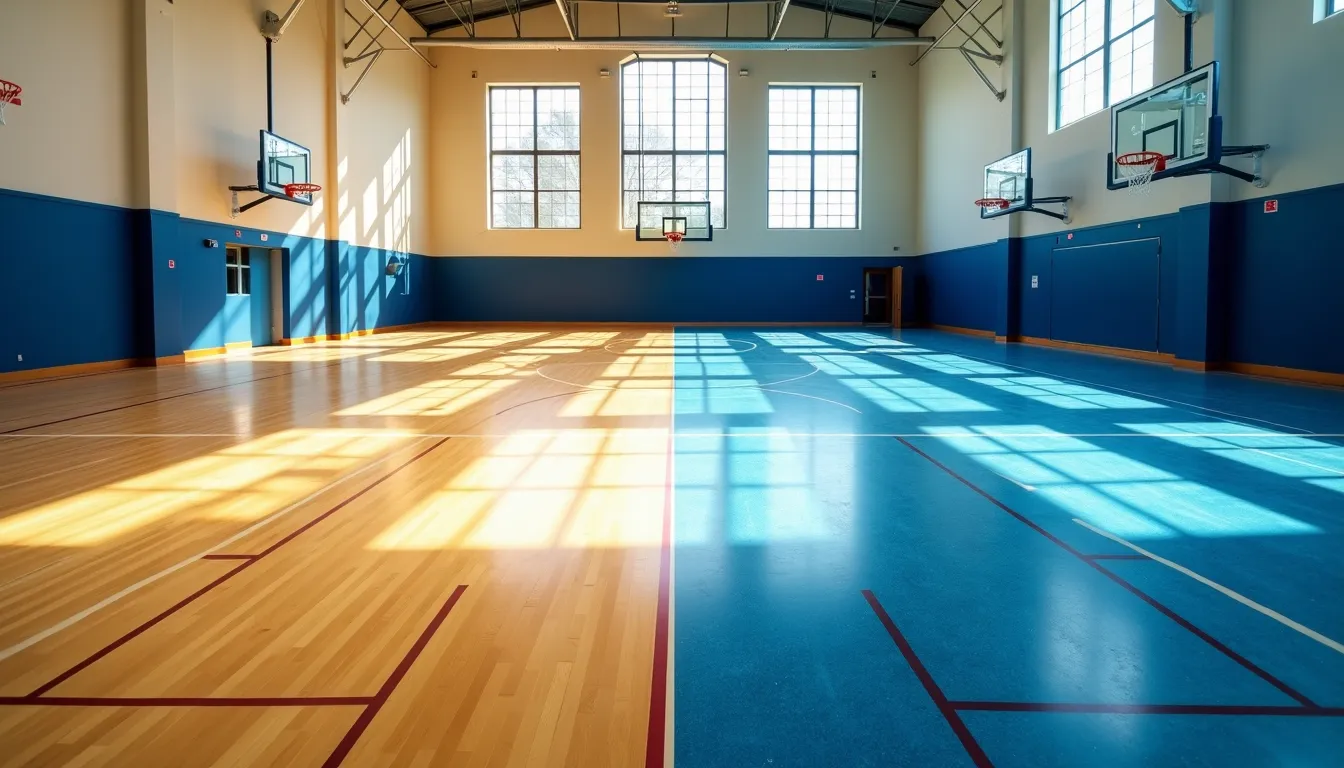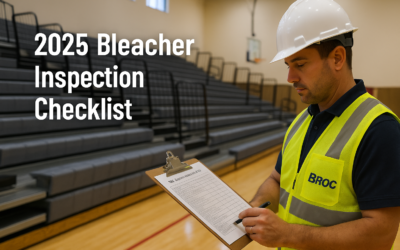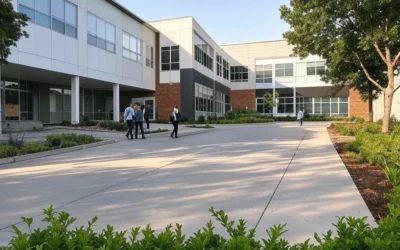Did you know that a poorly chosen gym floor material can lead to $100,000+ in unexpected repairs within just five years? That’s more than double the initial installation cost for many school gymnasiums.
Whether you’re building a new facility or renovating an existing one, selecting the right gym floor material impacts everything from student safety to your maintenance budget. In fact, the proper flooring choice can reduce student injuries by up to 40% while extending the floor’s lifespan by 10-15 years.
For school administrators, choosing between hardwood, synthetic, or composite gym floor materials often feels overwhelming. Each option comes with its own set of advantages, maintenance requirements, and cost implications that directly affect your school’s athletic programs and budget.
This comprehensive guide will walk you through the essential factors to consider when selecting gym flooring for your school, helping you make an informed decision that balances performance, safety, and long-term value.
Understanding Your Facility’s Unique Requirements
Selecting the right gym floor material begins with a thorough understanding of your facility’s specific needs. Elementary and middle schools require different flooring solutions compared to high schools, as they typically function as multi-purpose facilities 1.
Assessing Daily Usage Patterns and Traffic Flow
The first thing to remember is that flooring experiences the highest utilization rate of all gymnasium components 2. Accordingly, understanding your daily foot traffic patterns is crucial. Heavy foot traffic and repeated facility use significantly impact floor durability and maintenance requirements 2.
Key assessment steps include:
- Measuring your facility’s size and space allocation
- Calculating expected daily user volume
- Mapping primary traffic routes
- Identifying peak usage periods
Sport-Specific Performance Needs
Specifically, your gym floor must meet standardized performance criteria for athletic activities. The ASTM F2772 standard measures four essential factors 3:
- Force reduction (shock absorption)
- Surface finish effect (friction)
- Ball rebound capability
- Vertical deformation
Furthermore, high school facilities need flooring that can withstand competitive sports demands, particularly for basketball and volleyball 1. The floor must be sturdy enough to support equipment like bleachers, posts, stands, and floor sockets 2.
Multi-Purpose Functionality Requirements
Important to realize, most school gymnasiums serve multiple functions beyond sports. Your flooring choice should accommodate various activities, including:
Physical education classes require floors with excellent shock absorption to prevent student fatigue 2. Additionally, if your facility hosts multiple simultaneous activities, consider flooring with noise reduction qualities to create a more peaceful environment 2.
The geographical location of your facility also plays a crucial role. For instance, areas with high humidity levels require special consideration, particularly if you’re considering hardwood flooring options 2. Synthetic options like rubber flooring offer superior water resistance, making them ideal for moisture-prone environments 2.
Comparing Different Gym Flooring Materials
Making an informed choice between different gym floor materials requires careful consideration of performance characteristics, safety features, and environmental impact. Let us explore the key differences that will help you make the right decision for your school.
Hardwood vs Synthetic Options
Maple hardwood flooring remains a classic choice for school gymnasiums, offering exceptional durability with a lifespan of up to 75 years under proper maintenance 4. As opposed to this, synthetic floors typically last around 30 years 4.
Here’s how these materials compare:
| Feature | Hardwood | Synthetic |
|---|---|---|
| Initial Cost | Higher upfront investment | More budget-friendly |
| Maintenance | Requires consistent humidity control | Easier to maintain |
| Best Use | Dedicated sports facilities | Multi-purpose spaces |
| Esthetics | Traditional gleam | Modern, customizable |
Impact Absorption and Safety Features
Above all, safety considerations should guide your flooring choice. Consequently, both options offer distinct advantages in terms of impact absorption and injury prevention.
Hardwood sports floors provide:
- Natural shock absorption
- Consistent ball bounce
- Excellent traction for athletic movements 5
Nevertheless, synthetic flooring offers superior moisture resistance and can be engineered with specific performance characteristics in mind 5. In essence, both materials meet standardized safety requirements, coupled with different maintenance demands.
Environmental Sustainability Factors
Modern gym flooring options increasingly emphasize environmental responsibility. Synthetic rubber flooring often contains recycled materials, primarily from vehicle tires 6. These eco-friendly options deliver several benefits:
- Minimal volatile organic compound (VOC) emissions 6
- Energy-efficient installation processes
- Extended product lifecycle 7
Hardwood flooring can support environmental goals through sustainable forestry practices 7. Moreover, some manufacturers now offer FSC certification for responsible wood sourcing 6. The choice between materials often depends on your facility’s specific sustainability goals and certification requirements.
Evaluating Long-Term Cost Implications
Understanding the financial implications of your gym floor choice requires careful consideration of both immediate and long-term expenses. Let’s examine the cost factors that will impact your budget over time.
Initial Installation Expenses
The upfront investment for gym flooring varies substantially based on material choice and facility size. Initially, hardwood installations range from $12.00 to $26.00 per square foot, whereas synthetic systems cost between $10.00 and $22.00 per square foot 8. These base costs typically include:
- Basic Installation: $3.50 – $5.00 per square foot
- Complex Installations: $5.00 – $7.50 per square foot
- Subfloor Preparation: $2.00 – $4.00 per square foot 9
Maintenance and Replacement Costs
Subsequently, annual maintenance expenses vary by flooring type:
| Floor Type | Annual Cost Range |
|---|---|
| Maple hardwood | $2,000 – $5,000 |
| Sports vinyl | $1,000 – $3,000 |
| Synthetic floors | $750 – $2,000 10 |
Regular maintenance includes screening and recoating, which costs $1.50 – $2.50 per square foot every 3-5 years 9. Generally, hardwood floors require refinishing every 5-10 years, depending on usage patterns 11.
Return on Investment Analysis
In terms of long-term value, properly maintained gym flooring can deliver substantial returns:
- Expected Lifespan: 35-50 years for well-maintained hardwood 9
- Property Value Impact: Up to 15% increase in facility value 9
- Protective Equipment Investment: $1.50 – $3.00 per square foot for floor covers 9
Primarily, the total lifecycle cost depends on usage intensity and maintenance quality. Hardwood floors might need resurfacing after 10-15 years, costing between $26,400 and $105,600 10. Ultimately, synthetic flooring requires less maintenance until replacement but typically needs complete replacement after this period 12.
To protect your investment, consider allocating funds for:
- Walk-off mats: $500 – $1,500 per entrance
- Equipment protective pads: $200 – $500 per set 9
Managing the Selection Process
Successful gym floor material selection requires a structured decision-making process that involves key stakeholders and clear evaluation criteria. A well-planned approach ensures your school makes an informed choice that serves both current and future needs.
Building a Decision Committee
The foundation of a successful selection process lies in assembling a diverse committee. Research shows that involving stakeholders from the beginning leads to better project outcomes 13. A balanced committee should include:
| Role | Responsibility |
|---|---|
| Facility Manager | Technical requirements |
| Athletic Director | Sports performance needs |
| Maintenance Staff | Upkeep considerations |
| Financial Officer | Budget oversight |
| Safety Officer | Compliance standards |
Gathering Stakeholder Input
Primarily, the success of your gym flooring project depends on comprehensive stakeholder engagement. Studies indicate that identifying and gathering input from all facility users is crucial for project success 14. Consider these key groups:
Internal stakeholders
- Physical education instructors
- Athletic coaches
- Maintenance personnel
- Student representatives
External stakeholders
- Community groups
- Athletic associations
- Environmental certification bodies
Given these points, utilize multiple communication channels to gather feedback, such as surveys, focus groups, and public forums 14. During this process, document all concerns and preferences to ensure comprehensive consideration of needs.
Creating Evaluation Criteria
At this point, developing clear evaluation criteria becomes essential for objective decision-making. In light of stakeholder input, establish a structured assessment framework that considers:
Performance Metrics
- Impact absorption rates
- Noise reduction capabilities
- Slip resistance standards
- Ball bounce requirements
Practical Considerations
- Installation timeline feasibility
- Maintenance resource availability
- Environmental control capabilities
- Budget constraints
Altogether, the evaluation process should incorporate both quantitative and qualitative factors. Before making the final decision, ensure your committee has thoroughly assessed each option against these criteria. Soon after establishing these parameters, you can begin comparing specific flooring options that align with your facility’s requirements 13.
Remember that facility managers are increasingly seeking cost-effective solutions that align with financial constraints 15. Therefore, your evaluation criteria should balance immediate needs with long-term value considerations.
Implementation and Installation Planning
Proper planning and execution of your gym floor material installation ensures optimal performance and longevity. A well-structured implementation strategy helps avoid costly delays and ensures quality results.
Timeline Development
Installing a new gym floor requires careful scheduling and coordination. Primarily, a complete installation typically spans 6-8 weeks for new facilities 16. The timeline breaks down into distinct phases:
Material Delivery and Acclimation (2-3 weeks)
- Unload and store materials
- Maintain temperature between 55-75 degrees
- Control relative humidity at 35-50% 16
Installation and Finishing (3-4 weeks)
- Subfloor preparation
- Material installation
- Sanding and sealing
- Game line painting
Curing Period (1-2 weeks)
- Allow proper drying time
- Restrict access to the facility
Contractor Selection Process
Selecting the right contractor is essential for project success. Indeed, experienced contractors bring specialized knowledge that directly impacts installation quality 17. Consider these evaluation criteria:
| Criteria | Key Considerations |
|---|---|
| Experience | Track record with similar projects |
| Certification | Industry-specific credentials |
| References | Past client testimonials |
| Equipment | Modern installation tools |
| Insurance | Adequate coverage for project scope |
Notably, reputable contractors should demonstrate:
- Thorough moisture mapping capabilities
- Dust containment systems
- Temperature and humidity control expertise 18
Quality Control Measures
Evidently, maintaining strict quality control throughout the installation process safeguards your investment. Essential quality control measures include:
Environmental Monitoring
- Daily temperature readings
- Humidity level documentation
- Moisture content testing 3
Installation Verification
- Subfloor preparation inspection
- Material acclimation confirmation
- Adhesive application oversight
Ultimately, proper quality control requires:
- Regular site inspections
- Detailed documentation
- Performance testing
- Warranty compliance verification 18
The installation team should utilize specialized equipment for testing and verification. Regular moisture mapping helps prevent issues like cupping or crowning that could compromise floor performance 18. For hardwood installations, maintaining proper expansion gaps and accounting for environmental factors becomes crucial for long-term stability.
Conclusion
Selecting the right gym floor material stands as a crucial decision that shapes your school’s athletic future and financial health. Careful consideration of performance requirements, maintenance capabilities, and installation processes ensures optimal outcomes for your facility.
Sound planning through stakeholder engagement, coupled with thorough contractor evaluation, significantly reduces unexpected complications. Additionally, proper quality control measures protect your investment while maximizing the floor’s lifespan.
Remember that successful gym flooring projects balance immediate needs with long-term value. Though hardwood and synthetic options each offer distinct advantages, your choice should align with specific facility requirements, maintenance resources, and budget constraints.
School administrators who follow this comprehensive approach create safe, durable, and cost-effective athletic spaces that serve their communities for decades. Certainly, the initial investment of time and resources in proper planning pays dividends through reduced maintenance costs and enhanced facility performance.
References
[1] – https://sportsvenuecalculator.com/knowledge/gymnasium-flooring/best-gym-flooring-for-schools/
[2] – https://www.mondoworldwide.com/na/en/spaziomondo/doyouknow/buying-school-gym-flooring/
[3] – https://www.endurance-flooring.com/ensuring-durable-gym-flooring-tips-for-long-lasting-floors/
[4] – https://www.sportsfloorsinc.com/wood-floors-vs-synthetic-floors/
[5] – https://www.tvs-sportssurfaces.com/the-differences-between-hardwood-and-synthetic-basketball-flooring/
[6] – https://gymfloors.com/blog/your-eco-friendly-gym-flooring-options-where-sustainability-meets-functionality/
[7] – https://zebraathletics.com/how-rubber-flooring-is-environmentally-friendly/?srsltid=AfmBOoq6Y7lUxl_7U78U7xiQ8pG0QjTFF_EX7-9TaOJJVdnc-KXw_-78
[8] – https://www.robbinsfloor.com/how-much-does-a-gym-floor-cost/
[9] – https://gymfloors.com/blog/gymnasium-flooring-cost/
[10] – https://sportsvenuecalculator.com/knowledge/indoor-sports-court/ultimate-guide-to-gymnasium-flooring-costs-materials-and-selection-criteria/
[11] – https://www.kieferusa.com/whats-new/refinish-resurface-replace-wood-gym-flooring/
[12] – https://sportsvenuecalculator.com/knowledge/gymnasium-flooring/gymnasium-flooring-options-2/
[13] – https://www.ironcompany.com/blog/ultimate-guide-gym-flooring?srsltid=AfmBOorbI4j4TJWcSDnSlFt_CkMxVNsd1U7-1nYuJ5SrkGuPvMTztf1S
[14] – https://www.athleticbusiness.com/facilities/rec-center/article/15147698/how-to-involve-all-stakeholders-in-the-design-process
[15] – https://www.kieferusa.com/blog/sports-flooring-athletic-surfaces-trends/
[16] – https://westernsportfloors.com/how-long-does-it-take-to-install-a-gym-floor/
[17] – https://www.rubcorp.com/a-step-by-step-guide-to-nike-grind-floor-installation/
[18] – https://gymfloors.com/blog/gym-floor-contractor/




